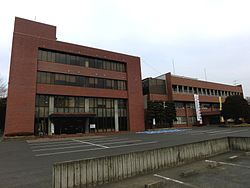Koga, Ibaraki
Koga
古河市 | |
|---|---|
 Koga city hall | |
|
Prunus persica | |
| Tree | Zelkova serrata |
Koga (古河市, Koga-shi) is a city located in Ibaraki Prefecture, Japan. As of 1 January 2024[update], the city had an estimated population of 137,512 in 58,276 households and a population density of 1113 persons per km². The percentage of the population aged over 65 was 28.98%.[1] The total area of the city is 123.58 square kilometres (47.71 sq mi).
Geography
Koga is located in the extreme southwestern corner of Ibaraki Prefecture. Located almost in the center of the
Surrounding municipalities
Ibaraki Prefecture
Climate
Koga has a Humid continental climate (Köppen Cfa) characterized by warm summers and cool winters with light snowfall. The average annual temperature in Koga is 14.9 °C (58.8 °F). The average annual rainfall is 1,229.9 mm (48.42 in) with September as the wettest month. The temperatures are highest on average in August, at around 26.8 °C (80.2 °F), and lowest in January, at around 3.6 °C (38.5 °F).[2]
| Climate data for Koga (1991−2020 normals, extremes 1978−present) | |||||||||||||
|---|---|---|---|---|---|---|---|---|---|---|---|---|---|
| Month | Jan | Feb | Mar | Apr | May | Jun | Jul | Aug | Sep | Oct | Nov | Dec | Year |
| Record high °C (°F) | 18.8 (65.8) |
23.4 (74.1) |
26.1 (79.0) |
31.4 (88.5) |
35.1 (95.2) |
38.0 (100.4) |
39.5 (103.1) |
39.6 (103.3) |
38.2 (100.8) |
33.1 (91.6) |
24.7 (76.5) |
25.3 (77.5) |
39.6 (103.3) |
| Mean daily maximum °C (°F) | 9.2 (48.6) |
10.3 (50.5) |
14.0 (57.2) |
19.6 (67.3) |
24.1 (75.4) |
26.6 (79.9) |
30.6 (87.1) |
32.0 (89.6) |
27.8 (82.0) |
21.9 (71.4) |
16.4 (61.5) |
11.4 (52.5) |
20.3 (68.6) |
| Daily mean °C (°F) | 3.6 (38.5) |
4.6 (40.3) |
8.2 (46.8) |
13.5 (56.3) |
18.4 (65.1) |
21.8 (71.2) |
25.6 (78.1) |
26.8 (80.2) |
23.0 (73.4) |
17.2 (63.0) |
11.0 (51.8) |
5.8 (42.4) |
15.0 (58.9) |
| Mean daily minimum °C (°F) | −1.3 (29.7) |
−0.5 (31.1) |
2.9 (37.2) |
8.0 (46.4) |
13.6 (56.5) |
18.0 (64.4) |
21.9 (71.4) |
23.0 (73.4) |
19.3 (66.7) |
13.2 (55.8) |
6.3 (43.3) |
0.9 (33.6) |
10.4 (50.8) |
| Record low °C (°F) | −11.9 (10.6) |
−8.3 (17.1) |
−4.8 (23.4) |
−1.4 (29.5) |
2.3 (36.1) |
10.6 (51.1) |
14.5 (58.1) |
15.6 (60.1) |
8.4 (47.1) |
2.1 (35.8) |
−2.4 (27.7) |
−6.3 (20.7) |
−11.9 (10.6) |
| Average precipitation mm (inches) | 35.2 (1.39) |
35.1 (1.38) |
75.9 (2.99) |
91.3 (3.59) |
120.8 (4.76) |
132.0 (5.20) |
147.3 (5.80) |
135.8 (5.35) |
181.4 (7.14) |
166.1 (6.54) |
61.6 (2.43) |
37.7 (1.48) |
1,229.9 (48.42) |
| Average precipitation days (≥ 1.0 mm) | 3.9 | 4.6 | 8.6 | 9.4 | 11.0 | 12.1 | 11.6 | 8.6 | 11.0 | 10.2 | 6.0 | 4.2 | 101.2 |
| Mean monthly sunshine hours | 208.7 | 195.1 | 197.2 | 190.6 | 184.7 | 128.6 | 144.7 | 168.1 | 133.1 | 145.1 | 165.0 | 188.5 | 2,049.5 |
| Source: Japan Meteorological Agency[3][2] | |||||||||||||
Demographics
Per Japanese census data,[4] the population of Koga peaked around the year 2000 and has declined slightly since.
| Year | Pop. | ±% |
|---|---|---|
| 1950 | 78,478 | — |
| 1960 | 82,446 | +5.1% |
| 1970 | 97,659 | +18.5% |
| 1980 | 117,691 | +20.5% |
| 1990 | 139,239 | +18.3% |
| 2000 | 146,452 | +5.2% |
| 2010 | 142,995 | −2.4% |
| 2020 | 139,344 | −2.6% |
History
Koga was settled in the
highway.The town of Koga was established on April 1, 1889, with the creation of the modern municipalities system. It was raised to city status on August 1, 1950. On September 12, 2005, Koga absorbed the towns of Sanwa and Sōwa (both from Sashima District) to create the new and expanded city of Koga. The new city hall is now located at the former town of Sōwa.
Government
Koga has a
Economy
Koga was known in the Meiji era through the prewar Shōwa era as a center for sericulture. At present, the economy is highly industrialized, with the number of factories as second within Ibaraki Prefecture, after Hitachi city.
Education
Koga has 23 public elementary schools and nine public middle schools operated by the city government, and five public high schools operated by the Ibaraki Prefectural Board of Education. In addition, there is one private high school.
Transportation
bus
Highway
Sister city relations
Local attractions
- site of Koga Castle
- site of Koga Kubo residence
- Suzume-jinja
- Hase Kannon temple
- Koga History Museum
- Sogo Koen Park, near the Watarase River, was formally a summer palace for a local daimyo. It has two restored 17th century farmhouses, like including the Nakayama house and Takami Senseki house/museum.
- Navel Park in Sowa-machi has outdoor and barbecue facilities for families.
- Koga west of the station is old and has many old buildings. Many of the streets are cobbled.
- Tenkoku Art Museum.
Notable people
- Hideo Jinpu, politician
- Kawanabe Kyōsai, artist
- Okuhara Seiko, artist
- Reiko Okano, manga artist
- Koji Yamamuro, Olympic gymnast
References
- ^ "Ibaraki prefectural official statistics" (in Japanese). Japan.
- ^ a b 気象庁 / 平年値(年・月ごとの値). JMA. Retrieved April 1, 2022.
- ^ 観測史上1~10位の値(年間を通じての値). JMA. Retrieved April 1, 2022.
- ^ Koga population statistics
External links
- Official Website (in Japanese)
